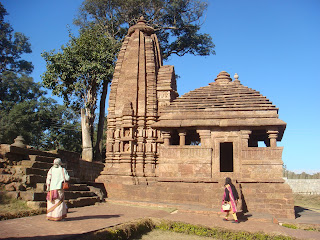This is part one of a three (or more) part tour-de-excellence through Madhya
Pradesh, the very heart of the Indian subcontinent.
Indeed, when I set out for this journey, little did I know that this would turn
out to be one of the most incredible travelling experiences I've ever been on -
which
is a significant thing, considering that Jammu-Kashmir and Kerala
are the
only two states in India that I haven't been to. So, I was both
apprehensive yet expectant of the "wonders" that I would behold in
the course of ten odd days.
With this and the next few blog posts, I wish to recount the experiences
that I have had in the past few days, and hope to take you, the reader down to
the very beginning of life on earth, to the roots of the present day
homo sapien and some astonishing
milestones of Indian culture - which still affects our day to day life in the
21st century.
Our journey begins on the road, aboard a rattly Chevrolet Tavera, at
Amarkantak. Amarkantak, situated in Madhya Pradesh, close to the MP-Chattisgarh
border is home to some of the oldest Shiv temples on the planet. These are some
outstanding works of art, dating back to 1000 AD - all sculpted out of stone.
One look at the temples and one is compelled to wonder at the craftsmanship of
the artisans who toiled with pickaxes and shovels and craved these brilliant
architectural masterpieces, which have stood the test of time and seen medieval
Indian history unfold alongside them.

Amarkantak is also of geographic importance as the source of the great
Narmada, which cuts through the rich igneous rocks of the Deccan plateau,
between the Vindhya and the Satpura ranges, and empties into the Arabian Sea in
Gujarat. Also, merely a couple of kilometers away from the source of the
Narmada is the source of the Son river. What is startling is that the entire
watershed region is such, that within a couple of kilometers, the altitude
varies so much that, the Narmada flows westward towards Gujarat, and that
the Son flows North East-ward to join the Ganga in the great Northern Plains.
Leaving Amarkantak behind us, we travel westward, towards Jabalpur -
National Highway 22. We cross the two towns of Dindori and Shahpur and then
come to a fork and turn left. 14 kilometers down this road and we come to one
of the most amazing, yet little known places in India. In fact, it's the
only
such place that we have in our country, and even outside India, very few of
these exist.
The National Fossil Park Park.

The National Fossil Park at Ghughua, is a rare, an
extremely rare example of an entire
tropical evergreen forest being petrified over millions of years - resisting
all forms of biological decay while at it. Carbon dating has estimated that
these plant fossils date back to the late Cretaceous and the early Tertiary
period in the geological timescale. That is more than 65 million years ago.
Which is, well,
a hell lot. Considering that dinosaurs had just become
extinct then, and that the closest ancestor to the modern man was still many
millions of years away.
These fossils are predominantly of the prehistoric date palm and banana.
This treasure trove of natural history was unearthed by a Dr Dharmendra Prasad,
the statistical officer of the Mandla district of Madhya Pradesh, and after
realizing the significance of this natural wonder, the Government of India
declared this as a National Park in 1983.
(Click on the pictures for full blown 8 mega pixel resolutions.)
 |
| palm tree base fossil |
 |
| eucalyptus tree fossil |
 |
| my father with the guide who showed us around |
 |
| assorted petrified pre historic tree parts |
 |
| mollusc fossils embedded in rock |
 |
| plant parts turned to crystal |
Geological studies on the fossils excavated have proved several theories of
continental drift. The fact that the fossils are predominantly of evergreen
plants imply that 65 million years ago, this region of India enjoyed a warm
humid climate with plenty of rainfall all year around. Also, the discovery of a
number of eucalyptus tree fossils have verified that the Deccan plateu and present
day Australia (which have eucalyptus forests to this date) shared the same
landmass - that of the ancient Gondwanaland. Seeing the fossils -
million-year-old plants turned to stone - over the years - lying where they
once stood, witnessing the evolution of planet earth happening all around them
- the changing landscapes, new species appearing and dying out, the early
primates first learning the art of working with tools, the discovery of fire,
the appearance of the first
homo sapien
- is exciting enough to send a shudder up one's spine!
After a surreal experience, which I'm thankful to have witnessed, we board
our rattly old Chevy and head to Jabalpur.
Part two of our journey - the enchanting marble rocks of the Narmada valley
in Jabalpur will be taken up in the next post. :)
 The National Fossil Park at Ghughua, is a rare, an extremely rare example of an entire
tropical evergreen forest being petrified over millions of years - resisting
all forms of biological decay while at it. Carbon dating has estimated that
these plant fossils date back to the late Cretaceous and the early Tertiary
period in the geological timescale. That is more than 65 million years ago.
Which is, well, a hell lot. Considering that dinosaurs had just become
extinct then, and that the closest ancestor to the modern man was still many
millions of years away.
The National Fossil Park at Ghughua, is a rare, an extremely rare example of an entire
tropical evergreen forest being petrified over millions of years - resisting
all forms of biological decay while at it. Carbon dating has estimated that
these plant fossils date back to the late Cretaceous and the early Tertiary
period in the geological timescale. That is more than 65 million years ago.
Which is, well, a hell lot. Considering that dinosaurs had just become
extinct then, and that the closest ancestor to the modern man was still many
millions of years away. The National Fossil Park at Ghughua, is a rare, an extremely rare example of an entire
tropical evergreen forest being petrified over millions of years - resisting
all forms of biological decay while at it. Carbon dating has estimated that
these plant fossils date back to the late Cretaceous and the early Tertiary
period in the geological timescale. That is more than 65 million years ago.
Which is, well, a hell lot. Considering that dinosaurs had just become
extinct then, and that the closest ancestor to the modern man was still many
millions of years away.
The National Fossil Park at Ghughua, is a rare, an extremely rare example of an entire
tropical evergreen forest being petrified over millions of years - resisting
all forms of biological decay while at it. Carbon dating has estimated that
these plant fossils date back to the late Cretaceous and the early Tertiary
period in the geological timescale. That is more than 65 million years ago.
Which is, well, a hell lot. Considering that dinosaurs had just become
extinct then, and that the closest ancestor to the modern man was still many
millions of years away.










Comments